BTEC L2 Applied Science: Analyzing Human Impact on Environment
VerifiedAdded on 2023/06/14
|5
|1604
|214
Report
AI Summary
This report examines the impact of human activities on the environment, focusing on climate change, pollution, and potential mitigation strategies. It includes a survey assessing commuter behaviors and their carbon emissions, highlighting the environmental consequences of different transportation choices. The report also discusses methods scientists use to measure human impact over time, such as continuous assessment, direct observation, and simulation tests. Furthermore, it addresses the challenges of global warming denial and recommends proactive restoration programs, community sensitization, and support for local innovation to reduce environmental impacts. The report emphasizes the importance of collaboration between policymakers, environmental scientists, and the local community to effectively address environmental challenges. Desklib provides access to similar solved assignments and resources for students.
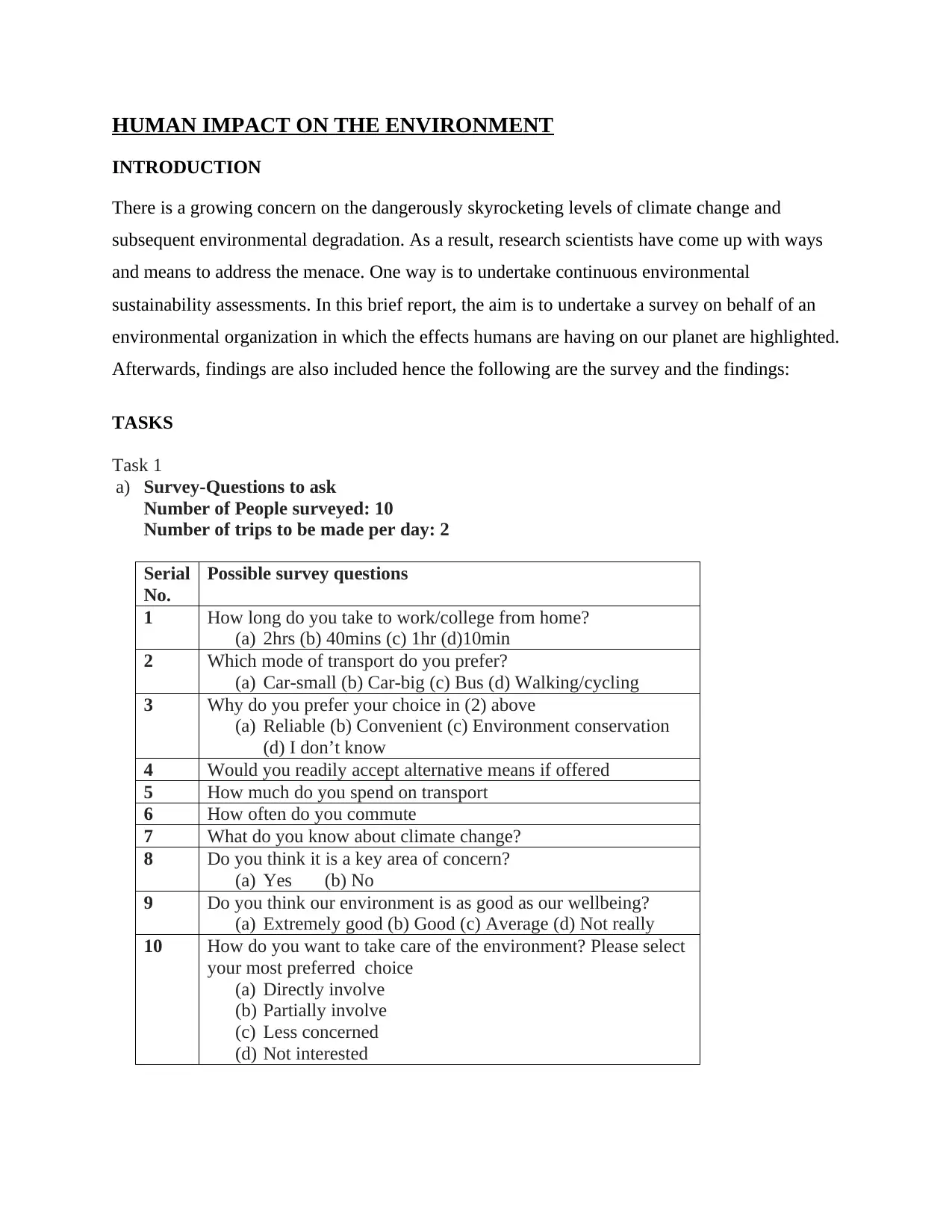
HUMAN IMPACT ON THE ENVIRONMENT
INTRODUCTION
There is a growing concern on the dangerously skyrocketing levels of climate change and
subsequent environmental degradation. As a result, research scientists have come up with ways
and means to address the menace. One way is to undertake continuous environmental
sustainability assessments. In this brief report, the aim is to undertake a survey on behalf of an
environmental organization in which the effects humans are having on our planet are highlighted.
Afterwards, findings are also included hence the following are the survey and the findings:
TASKS
Task 1
a) Survey-Questions to ask
Number of People surveyed: 10
Number of trips to be made per day: 2
Serial
No.
Possible survey questions
1 How long do you take to work/college from home?
(a) 2hrs (b) 40mins (c) 1hr (d)10min
2 Which mode of transport do you prefer?
(a) Car-small (b) Car-big (c) Bus (d) Walking/cycling
3 Why do you prefer your choice in (2) above
(a) Reliable (b) Convenient (c) Environment conservation
(d) I don’t know
4 Would you readily accept alternative means if offered
5 How much do you spend on transport
6 How often do you commute
7 What do you know about climate change?
8 Do you think it is a key area of concern?
(a) Yes (b) No
9 Do you think our environment is as good as our wellbeing?
(a) Extremely good (b) Good (c) Average (d) Not really
10 How do you want to take care of the environment? Please select
your most preferred choice
(a) Directly involve
(b) Partially involve
(c) Less concerned
(d) Not interested
INTRODUCTION
There is a growing concern on the dangerously skyrocketing levels of climate change and
subsequent environmental degradation. As a result, research scientists have come up with ways
and means to address the menace. One way is to undertake continuous environmental
sustainability assessments. In this brief report, the aim is to undertake a survey on behalf of an
environmental organization in which the effects humans are having on our planet are highlighted.
Afterwards, findings are also included hence the following are the survey and the findings:
TASKS
Task 1
a) Survey-Questions to ask
Number of People surveyed: 10
Number of trips to be made per day: 2
Serial
No.
Possible survey questions
1 How long do you take to work/college from home?
(a) 2hrs (b) 40mins (c) 1hr (d)10min
2 Which mode of transport do you prefer?
(a) Car-small (b) Car-big (c) Bus (d) Walking/cycling
3 Why do you prefer your choice in (2) above
(a) Reliable (b) Convenient (c) Environment conservation
(d) I don’t know
4 Would you readily accept alternative means if offered
5 How much do you spend on transport
6 How often do you commute
7 What do you know about climate change?
8 Do you think it is a key area of concern?
(a) Yes (b) No
9 Do you think our environment is as good as our wellbeing?
(a) Extremely good (b) Good (c) Average (d) Not really
10 How do you want to take care of the environment? Please select
your most preferred choice
(a) Directly involve
(b) Partially involve
(c) Less concerned
(d) Not interested
Paraphrase This Document
Need a fresh take? Get an instant paraphrase of this document with our AI Paraphraser
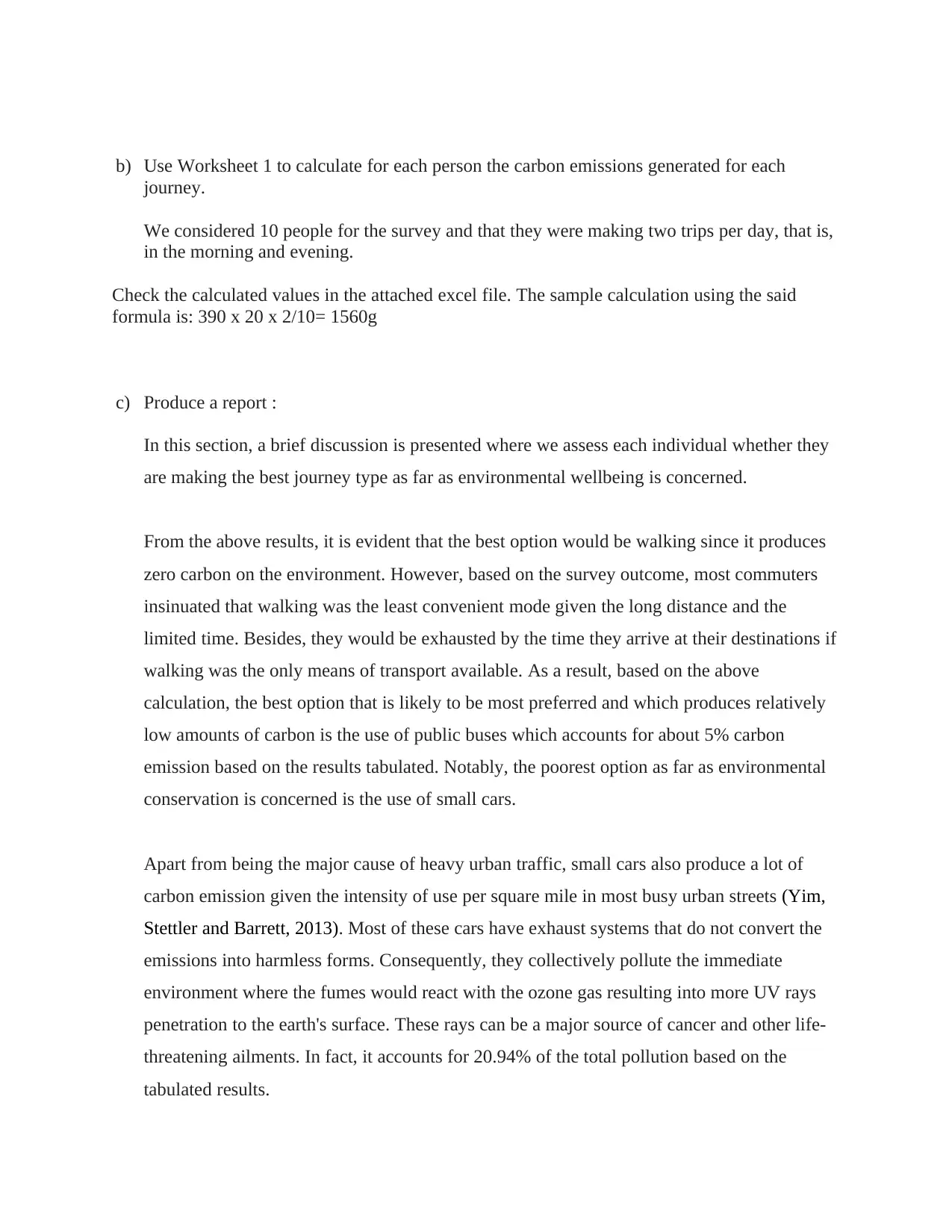
b) Use Worksheet 1 to calculate for each person the carbon emissions generated for each
journey.
We considered 10 people for the survey and that they were making two trips per day, that is,
in the morning and evening.
Check the calculated values in the attached excel file. The sample calculation using the said
formula is: 390 x 20 x 2/10= 1560g
c) Produce a report :
In this section, a brief discussion is presented where we assess each individual whether they
are making the best journey type as far as environmental wellbeing is concerned.
From the above results, it is evident that the best option would be walking since it produces
zero carbon on the environment. However, based on the survey outcome, most commuters
insinuated that walking was the least convenient mode given the long distance and the
limited time. Besides, they would be exhausted by the time they arrive at their destinations if
walking was the only means of transport available. As a result, based on the above
calculation, the best option that is likely to be most preferred and which produces relatively
low amounts of carbon is the use of public buses which accounts for about 5% carbon
emission based on the results tabulated. Notably, the poorest option as far as environmental
conservation is concerned is the use of small cars.
Apart from being the major cause of heavy urban traffic, small cars also produce a lot of
carbon emission given the intensity of use per square mile in most busy urban streets (Yim,
Stettler and Barrett, 2013). Most of these cars have exhaust systems that do not convert the
emissions into harmless forms. Consequently, they collectively pollute the immediate
environment where the fumes would react with the ozone gas resulting into more UV rays
penetration to the earth's surface. These rays can be a major source of cancer and other life-
threatening ailments. In fact, it accounts for 20.94% of the total pollution based on the
tabulated results.
journey.
We considered 10 people for the survey and that they were making two trips per day, that is,
in the morning and evening.
Check the calculated values in the attached excel file. The sample calculation using the said
formula is: 390 x 20 x 2/10= 1560g
c) Produce a report :
In this section, a brief discussion is presented where we assess each individual whether they
are making the best journey type as far as environmental wellbeing is concerned.
From the above results, it is evident that the best option would be walking since it produces
zero carbon on the environment. However, based on the survey outcome, most commuters
insinuated that walking was the least convenient mode given the long distance and the
limited time. Besides, they would be exhausted by the time they arrive at their destinations if
walking was the only means of transport available. As a result, based on the above
calculation, the best option that is likely to be most preferred and which produces relatively
low amounts of carbon is the use of public buses which accounts for about 5% carbon
emission based on the results tabulated. Notably, the poorest option as far as environmental
conservation is concerned is the use of small cars.
Apart from being the major cause of heavy urban traffic, small cars also produce a lot of
carbon emission given the intensity of use per square mile in most busy urban streets (Yim,
Stettler and Barrett, 2013). Most of these cars have exhaust systems that do not convert the
emissions into harmless forms. Consequently, they collectively pollute the immediate
environment where the fumes would react with the ozone gas resulting into more UV rays
penetration to the earth's surface. These rays can be a major source of cancer and other life-
threatening ailments. In fact, it accounts for 20.94% of the total pollution based on the
tabulated results.
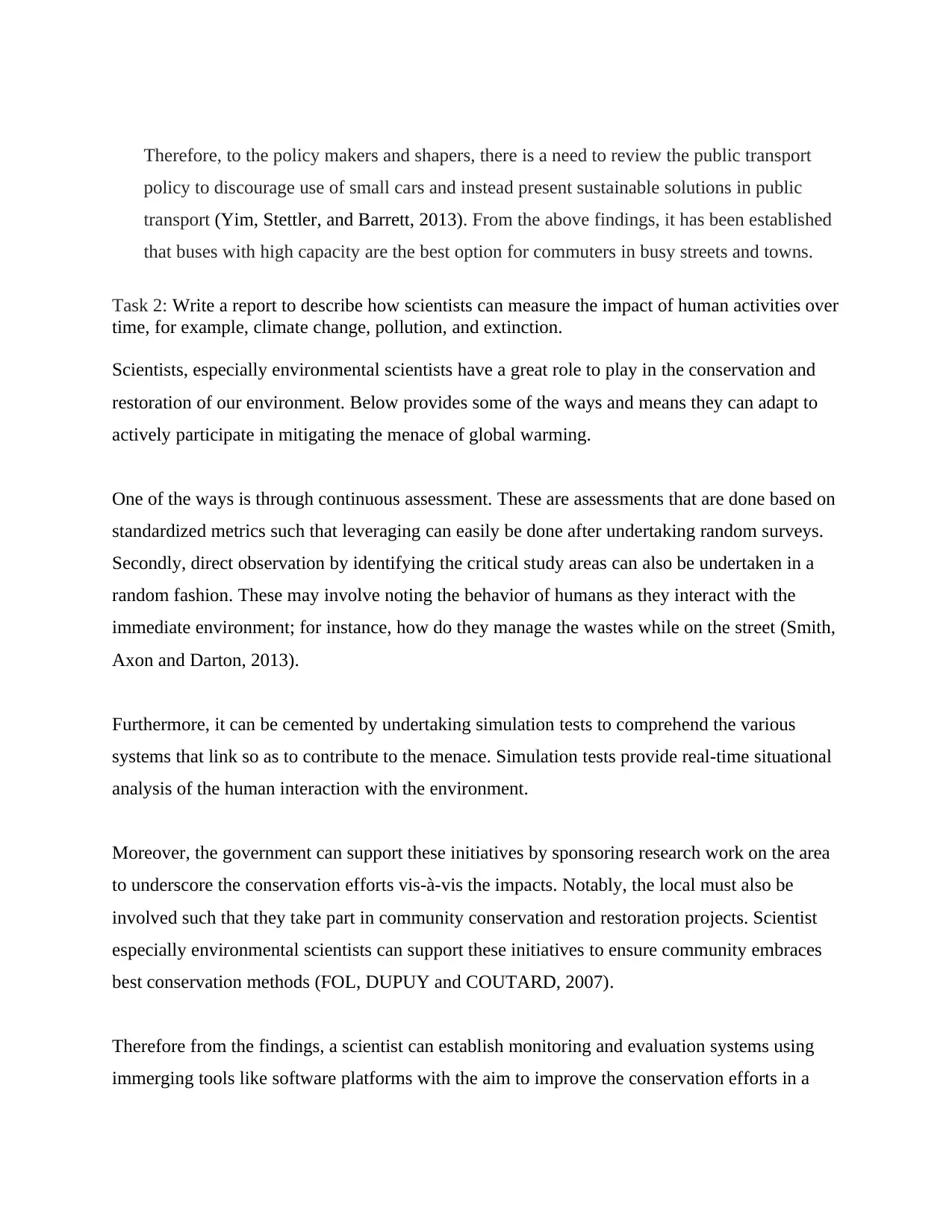
Therefore, to the policy makers and shapers, there is a need to review the public transport
policy to discourage use of small cars and instead present sustainable solutions in public
transport (Yim, Stettler, and Barrett, 2013). From the above findings, it has been established
that buses with high capacity are the best option for commuters in busy streets and towns.
Task 2: Write a report to describe how scientists can measure the impact of human activities over
time, for example, climate change, pollution, and extinction.
Scientists, especially environmental scientists have a great role to play in the conservation and
restoration of our environment. Below provides some of the ways and means they can adapt to
actively participate in mitigating the menace of global warming.
One of the ways is through continuous assessment. These are assessments that are done based on
standardized metrics such that leveraging can easily be done after undertaking random surveys.
Secondly, direct observation by identifying the critical study areas can also be undertaken in a
random fashion. These may involve noting the behavior of humans as they interact with the
immediate environment; for instance, how do they manage the wastes while on the street (Smith,
Axon and Darton, 2013).
Furthermore, it can be cemented by undertaking simulation tests to comprehend the various
systems that link so as to contribute to the menace. Simulation tests provide real-time situational
analysis of the human interaction with the environment.
Moreover, the government can support these initiatives by sponsoring research work on the area
to underscore the conservation efforts vis-à-vis the impacts. Notably, the local must also be
involved such that they take part in community conservation and restoration projects. Scientist
especially environmental scientists can support these initiatives to ensure community embraces
best conservation methods (FOL, DUPUY and COUTARD, 2007).
Therefore from the findings, a scientist can establish monitoring and evaluation systems using
immerging tools like software platforms with the aim to improve the conservation efforts in a
policy to discourage use of small cars and instead present sustainable solutions in public
transport (Yim, Stettler, and Barrett, 2013). From the above findings, it has been established
that buses with high capacity are the best option for commuters in busy streets and towns.
Task 2: Write a report to describe how scientists can measure the impact of human activities over
time, for example, climate change, pollution, and extinction.
Scientists, especially environmental scientists have a great role to play in the conservation and
restoration of our environment. Below provides some of the ways and means they can adapt to
actively participate in mitigating the menace of global warming.
One of the ways is through continuous assessment. These are assessments that are done based on
standardized metrics such that leveraging can easily be done after undertaking random surveys.
Secondly, direct observation by identifying the critical study areas can also be undertaken in a
random fashion. These may involve noting the behavior of humans as they interact with the
immediate environment; for instance, how do they manage the wastes while on the street (Smith,
Axon and Darton, 2013).
Furthermore, it can be cemented by undertaking simulation tests to comprehend the various
systems that link so as to contribute to the menace. Simulation tests provide real-time situational
analysis of the human interaction with the environment.
Moreover, the government can support these initiatives by sponsoring research work on the area
to underscore the conservation efforts vis-à-vis the impacts. Notably, the local must also be
involved such that they take part in community conservation and restoration projects. Scientist
especially environmental scientists can support these initiatives to ensure community embraces
best conservation methods (FOL, DUPUY and COUTARD, 2007).
Therefore from the findings, a scientist can establish monitoring and evaluation systems using
immerging tools like software platforms with the aim to improve the conservation efforts in a
⊘ This is a preview!⊘
Do you want full access?
Subscribe today to unlock all pages.

Trusted by 1+ million students worldwide
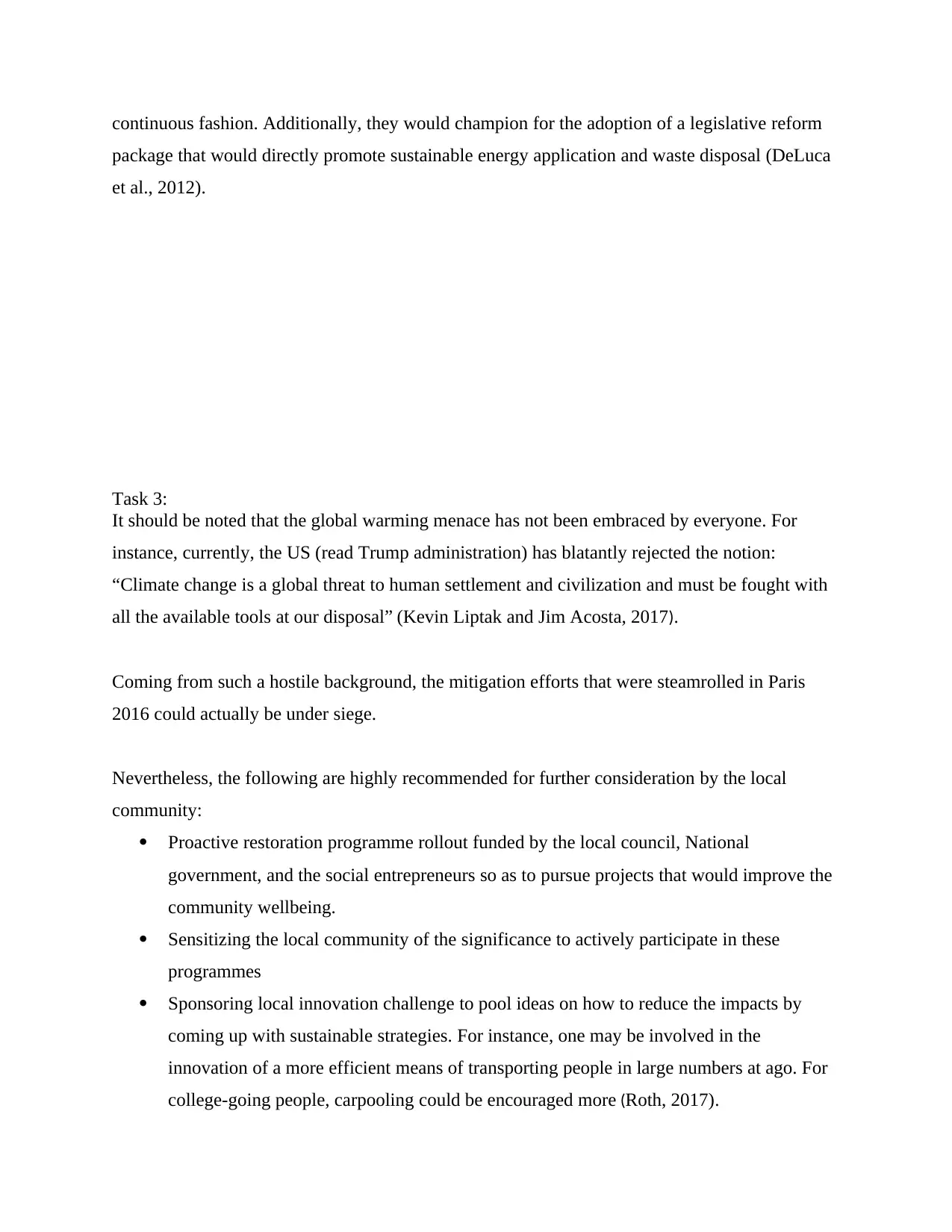
continuous fashion. Additionally, they would champion for the adoption of a legislative reform
package that would directly promote sustainable energy application and waste disposal (DeLuca
et al., 2012).
Task 3:
It should be noted that the global warming menace has not been embraced by everyone. For
instance, currently, the US (read Trump administration) has blatantly rejected the notion:
“Climate change is a global threat to human settlement and civilization and must be fought with
all the available tools at our disposal” (Kevin Liptak and Jim Acosta, 2017).
Coming from such a hostile background, the mitigation efforts that were steamrolled in Paris
2016 could actually be under siege.
Nevertheless, the following are highly recommended for further consideration by the local
community:
Proactive restoration programme rollout funded by the local council, National
government, and the social entrepreneurs so as to pursue projects that would improve the
community wellbeing.
Sensitizing the local community of the significance to actively participate in these
programmes
Sponsoring local innovation challenge to pool ideas on how to reduce the impacts by
coming up with sustainable strategies. For instance, one may be involved in the
innovation of a more efficient means of transporting people in large numbers at ago. For
college-going people, carpooling could be encouraged more (Roth, 2017).
package that would directly promote sustainable energy application and waste disposal (DeLuca
et al., 2012).
Task 3:
It should be noted that the global warming menace has not been embraced by everyone. For
instance, currently, the US (read Trump administration) has blatantly rejected the notion:
“Climate change is a global threat to human settlement and civilization and must be fought with
all the available tools at our disposal” (Kevin Liptak and Jim Acosta, 2017).
Coming from such a hostile background, the mitigation efforts that were steamrolled in Paris
2016 could actually be under siege.
Nevertheless, the following are highly recommended for further consideration by the local
community:
Proactive restoration programme rollout funded by the local council, National
government, and the social entrepreneurs so as to pursue projects that would improve the
community wellbeing.
Sensitizing the local community of the significance to actively participate in these
programmes
Sponsoring local innovation challenge to pool ideas on how to reduce the impacts by
coming up with sustainable strategies. For instance, one may be involved in the
innovation of a more efficient means of transporting people in large numbers at ago. For
college-going people, carpooling could be encouraged more (Roth, 2017).
Paraphrase This Document
Need a fresh take? Get an instant paraphrase of this document with our AI Paraphraser
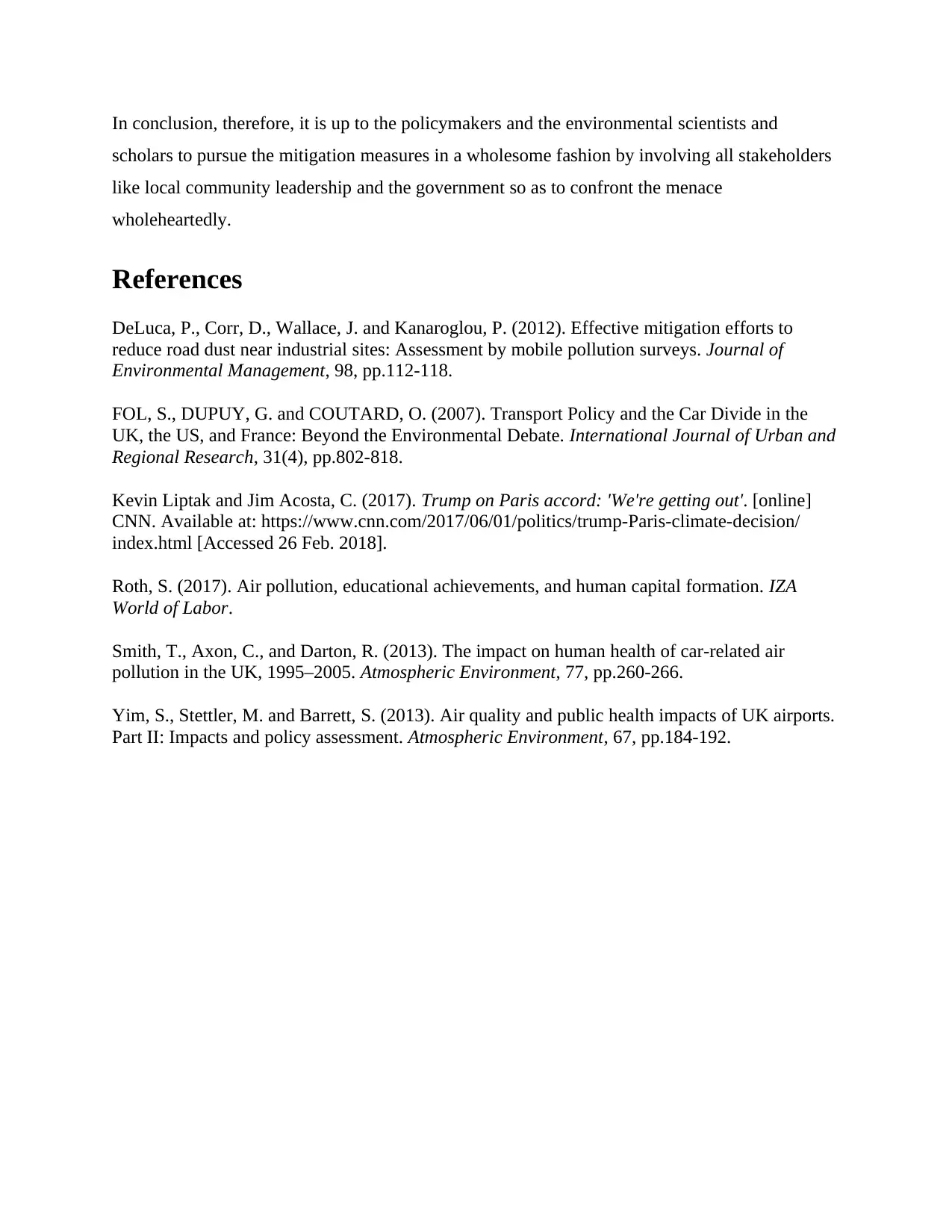
In conclusion, therefore, it is up to the policymakers and the environmental scientists and
scholars to pursue the mitigation measures in a wholesome fashion by involving all stakeholders
like local community leadership and the government so as to confront the menace
wholeheartedly.
References
DeLuca, P., Corr, D., Wallace, J. and Kanaroglou, P. (2012). Effective mitigation efforts to
reduce road dust near industrial sites: Assessment by mobile pollution surveys. Journal of
Environmental Management, 98, pp.112-118.
FOL, S., DUPUY, G. and COUTARD, O. (2007). Transport Policy and the Car Divide in the
UK, the US, and France: Beyond the Environmental Debate. International Journal of Urban and
Regional Research, 31(4), pp.802-818.
Kevin Liptak and Jim Acosta, C. (2017). Trump on Paris accord: 'We're getting out'. [online]
CNN. Available at: https://www.cnn.com/2017/06/01/politics/trump-Paris-climate-decision/
index.html [Accessed 26 Feb. 2018].
Roth, S. (2017). Air pollution, educational achievements, and human capital formation. IZA
World of Labor.
Smith, T., Axon, C., and Darton, R. (2013). The impact on human health of car-related air
pollution in the UK, 1995–2005. Atmospheric Environment, 77, pp.260-266.
Yim, S., Stettler, M. and Barrett, S. (2013). Air quality and public health impacts of UK airports.
Part II: Impacts and policy assessment. Atmospheric Environment, 67, pp.184-192.
scholars to pursue the mitigation measures in a wholesome fashion by involving all stakeholders
like local community leadership and the government so as to confront the menace
wholeheartedly.
References
DeLuca, P., Corr, D., Wallace, J. and Kanaroglou, P. (2012). Effective mitigation efforts to
reduce road dust near industrial sites: Assessment by mobile pollution surveys. Journal of
Environmental Management, 98, pp.112-118.
FOL, S., DUPUY, G. and COUTARD, O. (2007). Transport Policy and the Car Divide in the
UK, the US, and France: Beyond the Environmental Debate. International Journal of Urban and
Regional Research, 31(4), pp.802-818.
Kevin Liptak and Jim Acosta, C. (2017). Trump on Paris accord: 'We're getting out'. [online]
CNN. Available at: https://www.cnn.com/2017/06/01/politics/trump-Paris-climate-decision/
index.html [Accessed 26 Feb. 2018].
Roth, S. (2017). Air pollution, educational achievements, and human capital formation. IZA
World of Labor.
Smith, T., Axon, C., and Darton, R. (2013). The impact on human health of car-related air
pollution in the UK, 1995–2005. Atmospheric Environment, 77, pp.260-266.
Yim, S., Stettler, M. and Barrett, S. (2013). Air quality and public health impacts of UK airports.
Part II: Impacts and policy assessment. Atmospheric Environment, 67, pp.184-192.
1 out of 5
Your All-in-One AI-Powered Toolkit for Academic Success.
+13062052269
info@desklib.com
Available 24*7 on WhatsApp / Email
![[object Object]](/_next/static/media/star-bottom.7253800d.svg)
Unlock your academic potential
Copyright © 2020–2025 A2Z Services. All Rights Reserved. Developed and managed by ZUCOL.


